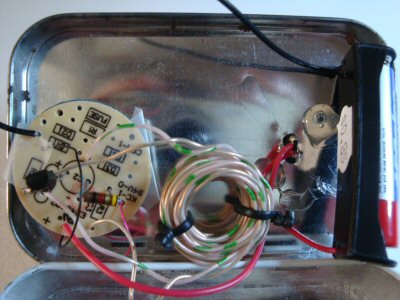Other LED Replacement ProjectsIn one of the parts catalogs, All Electronics, were some LED strips, both cool-white, #LS-123CW $3.25 each, or warm-white, #LS-123WW $30 for ten strips. These were either in plastic cases or bare strips. The ones in plastic cases were more expensive; $3.25/each, $3.00 each for 10 or more. The ones just in a ribbon strip cost $2.35/each or $1.75 each, for 10 or more. With such inexpensive LEDs I wanted to see what could be done to improve/replace lighting and reduce the cost of using electricity throughout the house. What follows are just a few of the projects I've done with these LED strips. Some not shown are lights for the basement, walk lights outside, and replacing some of the outdoor lights with ones I built from these LED strips in a similar way as was done building the piano light, except the strips were wound around a plastic pill bottle for 360 degree illumination. A pill bottle with a wide enough opening was used so the 12V 500mA power supply circuit board could be slipped inside the bottle. I have also made what I call my Traveler's Night Light which simply uses a diode, LED, AC Capacitor, & sometimes a resistor all inside a non-polarized AC replacement plug one can get from a hardware store. Car Trunk (Boot) LightingHam (Radio) Shack LightingI figured that two of these strips of three warm-white LEDs should be able to replace the long 40W incandescent light bulb. The question was how to power them. They needed 12V and each three-LED strip used about 40mA, so the two strips would need at least 80mA. In the same ALL Electronics parts catalog, I found a 12V 500mA switching power supply, #PS-1251, for $8.50. The nice thing about switching supplies is that they tend to use only enough electricity to get the job done. In other words, since these two LED strips needed 80mA at 12V (which is 0.96W) I could expect the power suppy to use about one Watt of power, not the full 12V at 500mA or six Watts. As it turned out the LED "bulb" did use only one Watt when I measured it using a Kill-O-Watt meter. LED Tester, no core used!
The LED Piano Light BulbLast, the new bulb was put into the piano lamp and turned on. The proof of the pudding was that my wife was able to use it in the evening when she was working on a new piece of music and didn't complain: no news is good news in this case. Assuming the power supply lasts as long as the expected life of the LEDs, which is 50000 hours, and based on using the bulb five hours/day, the new bulb will last about 27 years. The savings, based on $0.10 per KWhr, will be 39 Watts for five hours while it is in operation, times 365 days/yr, or about 71 KWhrs every year, or about $7 a year. Some other LED projects include the 5 LED Night Light that plugs into the AC wall socket and uses about 250mW (about 1/4 Watt.) and don't forget the Joule Thief test/experiments page that started all thess LED replacement lighting projects. Phil Karras, KE3FL 02/16/2014  Return to:
previous page
Return to:
[My Home page]
Return to:
previous page
Return to:
[My Home page]
|
